Reviews
At the Shed, Instagram-Ready Art Collective Drift Serves Up a Spectacle Made of Floating Pillars and Lightweight Ideas
'Fragile Future' is curated by Kathleen Forde of the experience-art company Superblue.
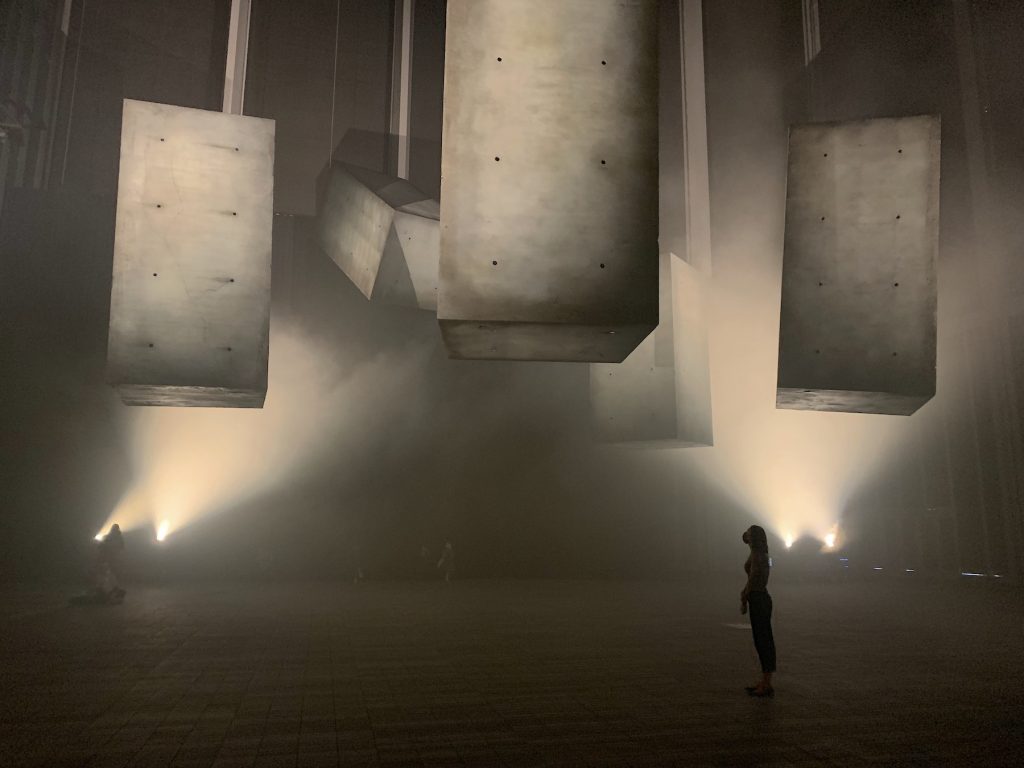
'Fragile Future' is curated by Kathleen Forde of the experience-art company Superblue.

Ben Davis

I’m a bit split about “Fragile Future,” the slick collection of installations by Amsterdam-based experience-art duo Drift (a.k.a. Lonneke Gordijn, Ralph Nauta, and their team of helpers), currently at the Shed.
In terms of what you see and experience, the show is fun. If you like Christmas light shows or Las Vegas magic acts—and I do personally like both these things—this will hit the spot. It’s art in that register.
But it also aims to be more than just fun. Drift wants to be taken seriously, both to inspire and to “ask fundamental questions.” And I just don’t know if I can take it that seriously.
Taking Drift seriously as art wasn’t as much of a concern in the recent past. As a group they were well-regarded, but their output was mainly Design Miami fare. Starting about 5 years ago, however, Drift began to assume a new profile as the visual art field itself took a more and more high-tech, experiential turn, and the proliferation of Instagram environments started to put pressure on museums (call this the Rain Room effect).
Drift has been drawing interest around the world—literally from NASA to Burning Man—via its work with choreographed drones. Recently, the group was picked up by Superblue, the new for-profit outfit sprung from the side of the Pace mega-gallery, which is pitching itself as a dedicated purveyor of interactive immersive art as a disruptive new market force. (In fact, Superblue’s curator gets credit as organizing “Fragile Future,” with the Shed seemingly reduced to helper status in its own venue.)
Drift was previously on the edge of the art world, in a quirky category of design-that-is-almost-art. Now it has leapfrogged so that it is being watched as something like the future of art. So the term “Fragile Future” has more than one meaning, and assessing it is about more than just whether, on its own, it is pleasant or not.

Installation view of Drift’s “Fragile Future” at the Shed in New York. Photo by Ben Davis.
In the Shed show, the sequence of Drift-engineered attractions is designed so that the works escalate in ambition as you go along. In a first gallery, you find the show’s title work, Fragile Future (2007–21), a complex concatenation of lamps, each pinpoint LED light embedded in what appears to be a real, fluffy dandelion, filling the shadowy space with a hazy, optimistic halo.
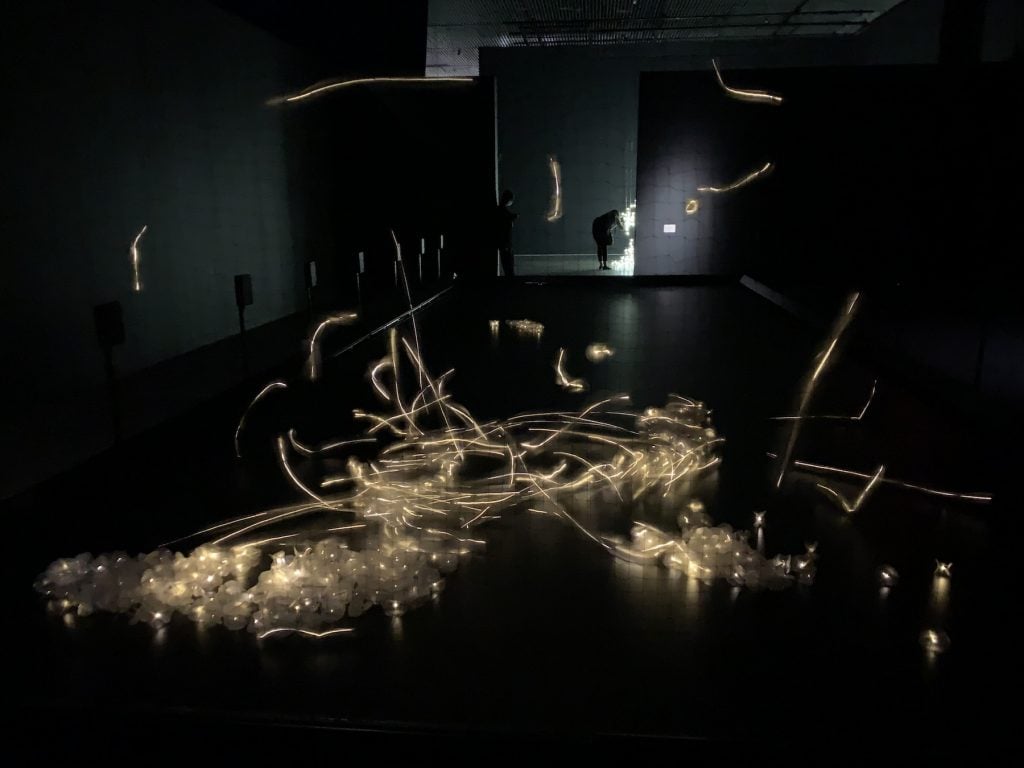
Drift, Coded Coincidence at the Shed. Photo by Ben Davis.
Passing to the next gallery, you come upon Coded Coincidence (2021). Air currents whip around inside a long rectangular area enclosed by nets, within which Drift has deposited a large number of small, lightweight LED nodules. Lifted by the intermittent gusts, the lights bluster around in the dark, forming swarms of arabesque-ing sparks in the air, skittering from one end to the next in a way that is supposed to evoke seeds carried by the wind.
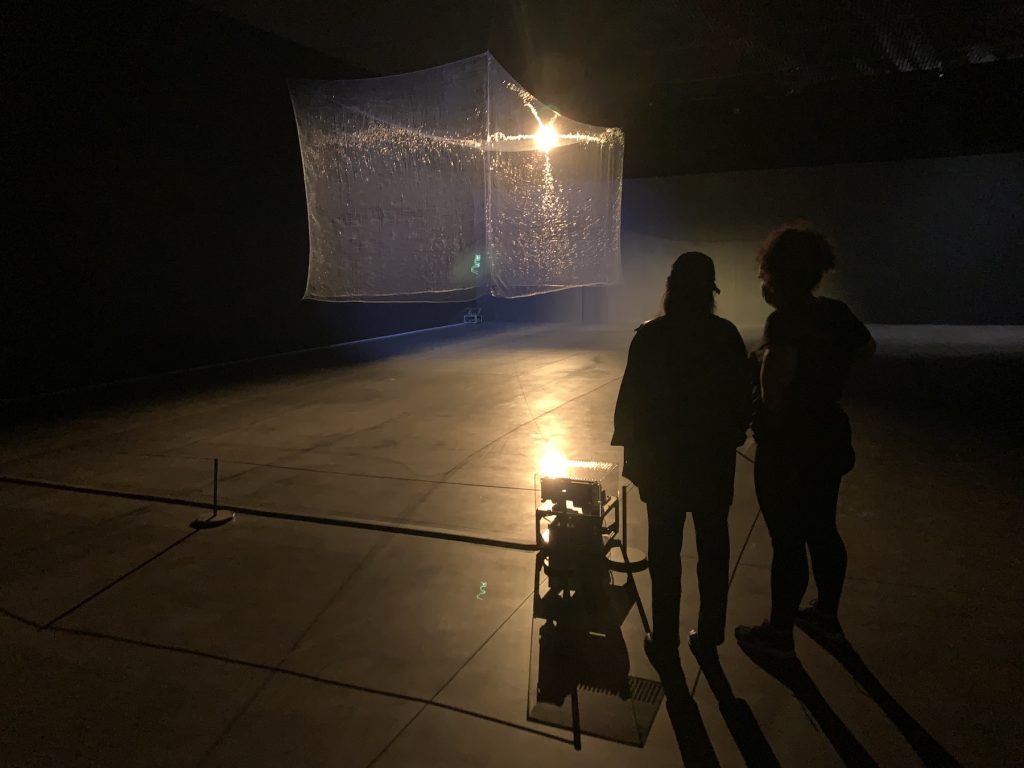
Drift, Ego, at the Shed. Photo by Ben Davis.
Turning a corner, you arrive at Ego (2020–21), a setup of diaphanous fabric panels suspended in the air by cables. As mechanized winches around the edges pull cables in and out in a pre-programmed sequence, the fabric is flexed into a number of different forms, each suggesting a different emotional state: a stable box, a tortured cone, a defeated plane slumping to the floor.
This is the piece that comes closest to making you feel something in “Fragile Future.” But then it is literally an exercise in forcing inanimate matter to pantomime emotion, conveying a bit of the sense of watching a robot flex facial features mechanically, cycling through human expressions.
In any case, these pieces are all engaging enough. But what everyone will remember from “Fragile Future” is Drifters, the show-stopping main attraction/performance, staged at select times as the centerpiece.
You approach this spectacle via a prologue gallery where two connected films play. One shows New York street scenes in which giant blocks of concrete float mysteriously through the air. The other depicts similar concrete blocks being birthed from the ground in the wilderness, congregating over a plane and assembling together into some kind of immense, mysterious Tower of Babel.
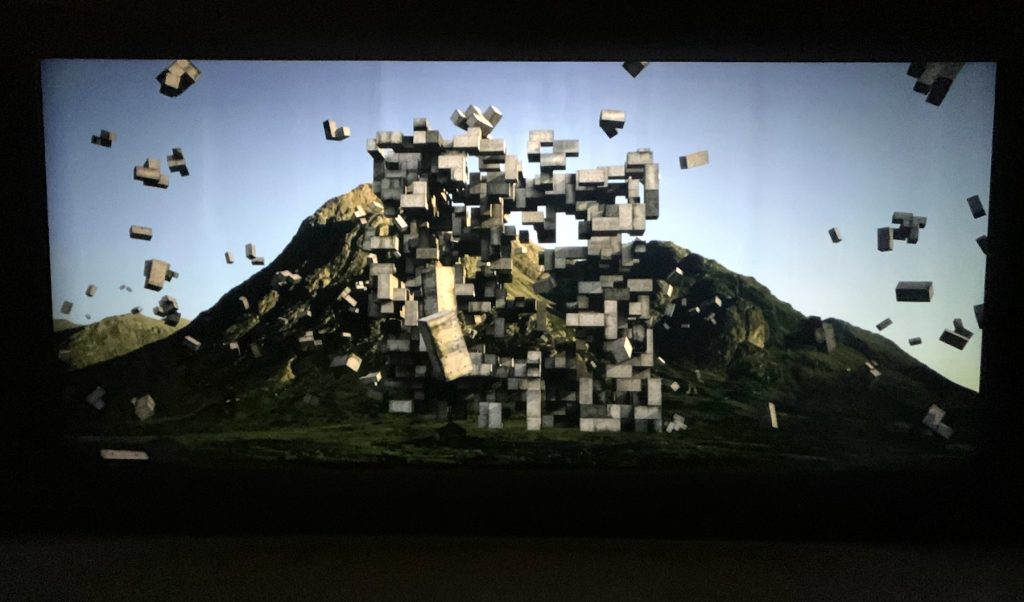
Stone blocks assemble in a film shown in Drifters at the Shed. Photo by Ben Davis.
After getting the sense of these films, you turn another corner and emerge into the Shed’s vast concert hall, its four-story ceiling towering above you. And there, actually levitating in the air above your head, are five of the enchanted concrete blocks—just like those in the film, only now in real life. (One such block was shown, to crowd-pleasing effect, at the Armory Show a few years ago, and was one of the works that made Drift’s reputation in the art world.)
A portentous, droning soundtrack courtesy ANOHNI (who is listed as a collaborator) projects awe and reverberates around you. The magic blocks are spotlit from all sides, with clouds of rock-concert smoke being expelled into the air periodically to accent it all with an atmosphere of drama.
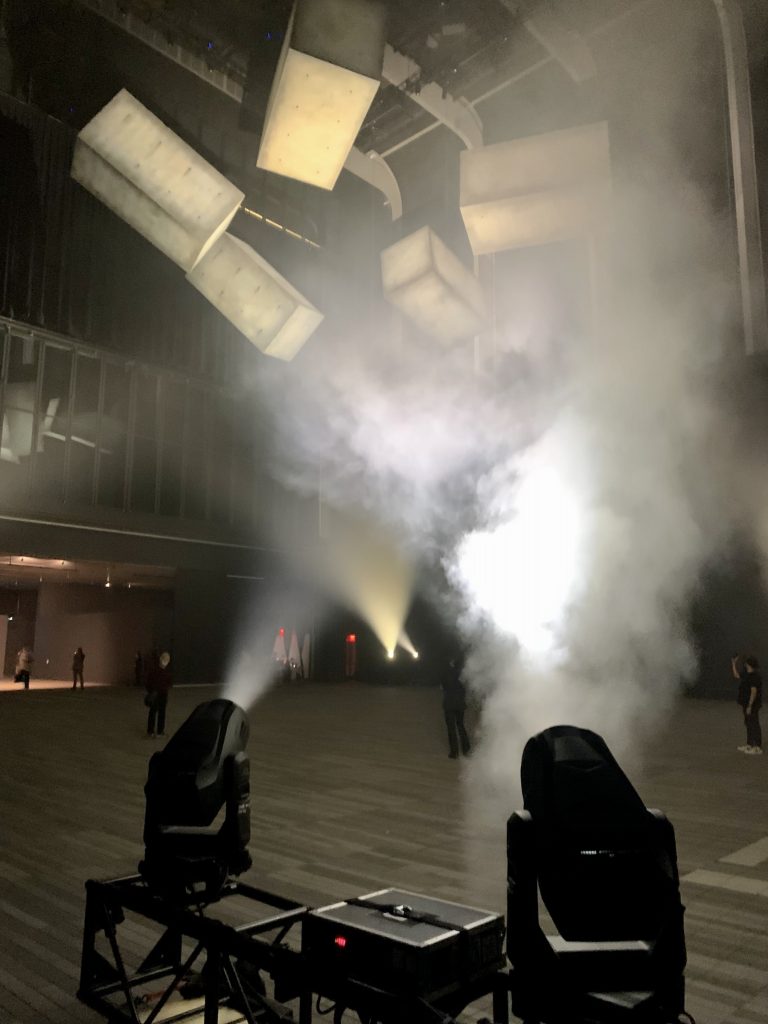
A smoke machine at work during the Drifters performance at the Shed. Photo by Ben Davis.
At first, these floating pylons drift aimlessly above, like rubble deposited in space by some kind of antigravity ray. Then, as you venture beneath them, or walk around the edges to get different views and marvel, the blocks gradually seem to wake up and to move with a kind of gathering purpose.
The music swells. The blocks unite into a pattern.
The first time I saw this show, the blocks assembled themselves vertically, formed a circle, and then descended deliberately until they were hovering just beyond the reach of the tallest person. It brought to mind an audition for a Stonehenge musical. Another time, they all went horizontal and formed a line, weaving deliberately in and out.
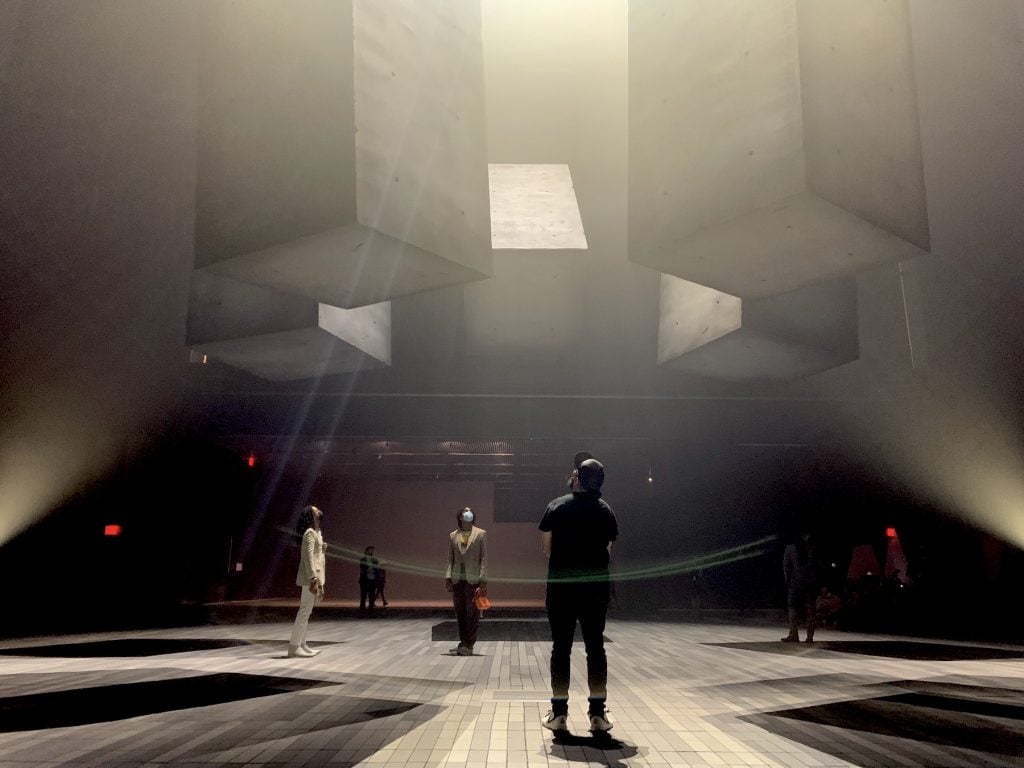
Visitors view Drift, Drifters, performed at the Shed. Photo by Ben Davis.
After each assembly, the blocks return to their more random and dispersed state, drifting around aimlessly for a bit before coming to life again, a cycle of about 20 minutes.
This is vintage Big Fun Art, and photogenic as hell. As to what it makes you feel or think about, Drifters benefits from your memories of countless Hollywood films and video games where some kind of mysterious alien structure comes to life to transmit some kind of coded cosmic epiphany. But what is the substance of that epiphany?
Starting with this show’s title, and extending through all the press around it, the artists’ own statements, and the wall text, there is an insistence on a specific mission for Drift, one that is both grandiose and indistinct. The Shed advertises them as artists who address “urgent environmental themes in their work in order to challenge their audiences to think differently about their connections to Earth,” offering “a hopeful atmosphere for imagining a different world.”
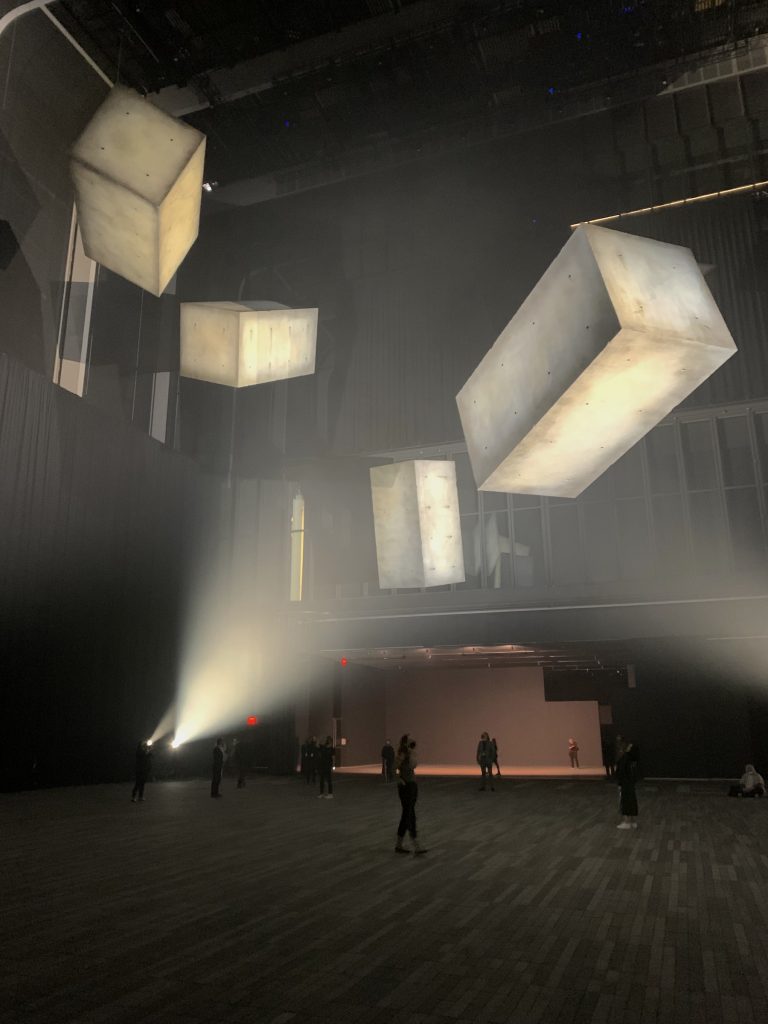
Visitors view the floating blocks in Drifters. Photo by Ben Davis.
All the works but Ego here feature variations on that promise of environmental consciousness-raising in their texts. But there is one remaining body of work I haven’t yet mentioned that particularly shows how Drift views its purpose: the “Materialism” series, consisting of clusters of differently sized rectangular volumes, made from a variety of different substances, arranged together on pedestals.
Via work descriptions, you quickly discover that each cluster represents the exact volume of different materials used in a variety of everyday tools: the work called Bike, for instance, is composed of a large rectangular volume of rubber, an aluminum rectangle, a smaller lacquer rectangle, and so on, to suggest bike components; iPhone is a dense cluster of tinier squares, in glass, stainless steel, polycarbonate, lithium cobalt oxide, graphite, etc.
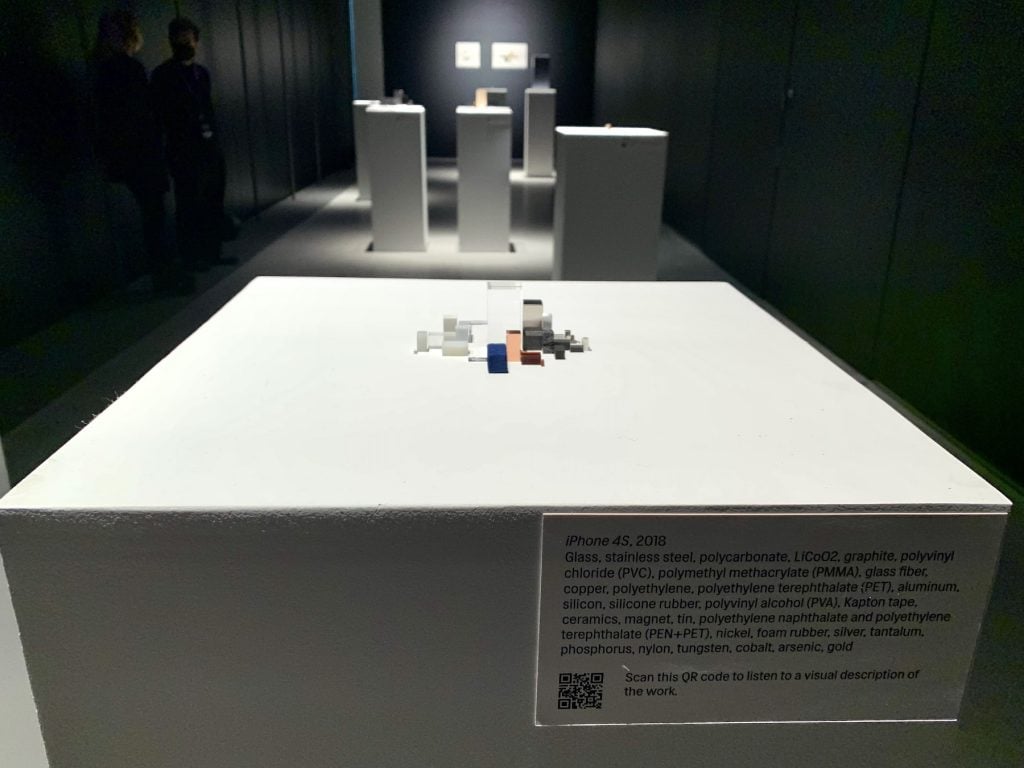
Drift, iPhone 4S (2018). Photo by Ben Davis.
“Everything that is bought and consumed has an impact upon complex systems of resource extraction, labor, manufacturing, and distribution,” the text explains. “The ‘Materialism’ series thus calls for contemplation on how people deal with the raw materials at their disposal.”
Beyond the general unease with toxic consumer culture that pervades affluent consciousness right now, this enjoinder reflects a very specific debate about values going on within the design field. Numerous designers have decried how design has played a role in lubricating a system of thoughtless consumption that is destroying the earth. Designers stand accused of encouraging people to covet cool forms and forget the underlying costs.
I’d argue that Drift’s “Materialism” series remains a little simplistic and mystifying in the designer-ly, materials-centric way it conveys this critical thought to its audience. Plenty of artists, from Allan Sekula to Jimmie Durham to Mika Rottenberg to Cameron Rowland, have forged sophisticated, thoughtful, and poetic ways of documenting the chains of human labor, energy expenditures, and environmental costs embedded in things we take for granted. And I doubt that it truly comes as a shock to the average Shed-goer that their bike is made of rubber and aluminum.
Nevertheless, there is something interesting about Drift’s deconstructive design gesture, and it is unusually specific in pointing to what they think they are doing that’s serious.
Returning to the enigmatic spectacle of Drifters, you can see the forms of the floating mystery blocks echoing the same rectangular volumes used in the decompositions of the iPhone and the bike—symbolizing a return to elemental reality, the basic building blocks of the world laid bare.
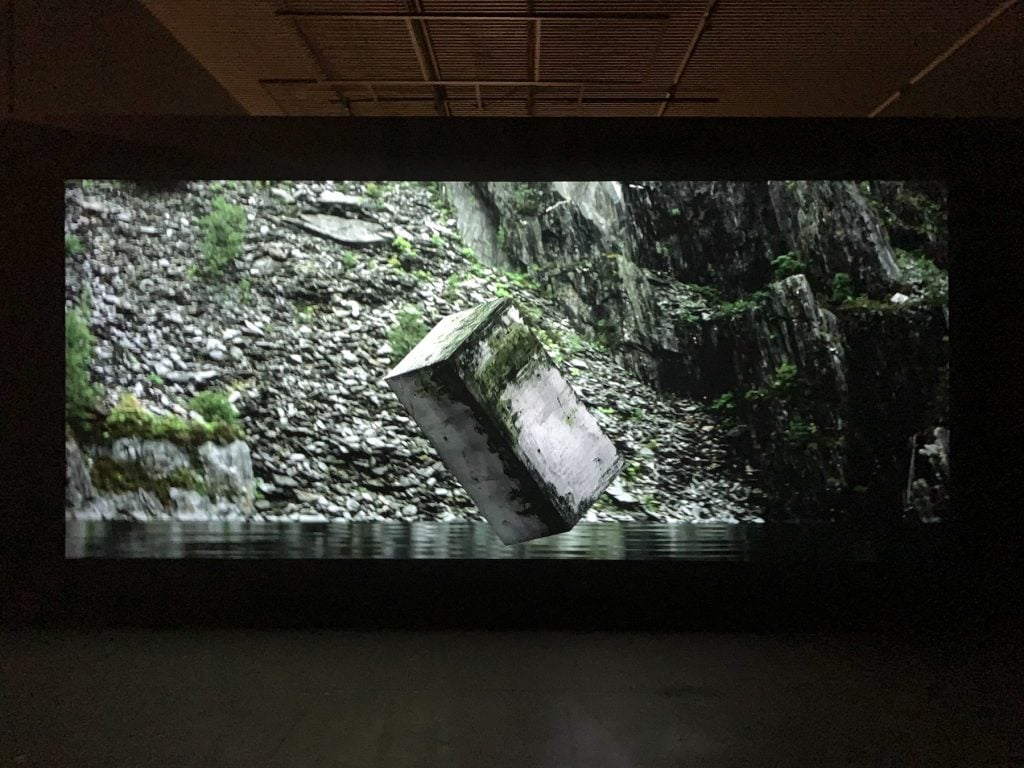
A stone block is depicted emerging from the muck in “Fragile Futures” at the Shed. Photo by Ben Davis.
This message is not super clear, conceptually, because the Drifters are obviously meant to be concrete, their main distinguishing feature being that they are studded with holes where rebar formwork ties usually stabilize the concrete during production. They thus evoke the built architectural environment and construction sites, not elemental materials—even though, in the film, the blocks seem to be shown emerging whole from nature.
My guess is that the holes are a scenographic device, not a conceptual one. If the floating blocks were simple gray volumes, they wouldn’t look like much. Your mind wouldn’t readily register the illusion of a heavy thing behaving unnaturally.
Notably, while “Materialism” is all about the critical gesture of detailing the fundamental components of design objects we take for granted, the labels for Drifters very deliberately do not explain how the floating-block trick works—and Drift’s members are very clear that they don’t want to explain. That would kill the magic. (If I had to guess, I’d say the blocks are big, disguised balloons, with some kind of interior drone setup so they can be steered. The soundtrack, in addition to telegraphing wonder, serves to cover what seems to be the keen of hidden rotors.) That’s fine if the note they are trying to hit is arena-rock, design-art entertainment, but it’s the reverse of some kind of contemplation of how the world works beneath all the bells and whistles of hyper-designed consumerism.
At any rate, the idea of Drifters comes into view in relation to the “Materialism” series: We have become alienated from our built environment, and the floating blocks represent some kind of higher, harmonious state of consciousness where we are returned to considering and respecting it.
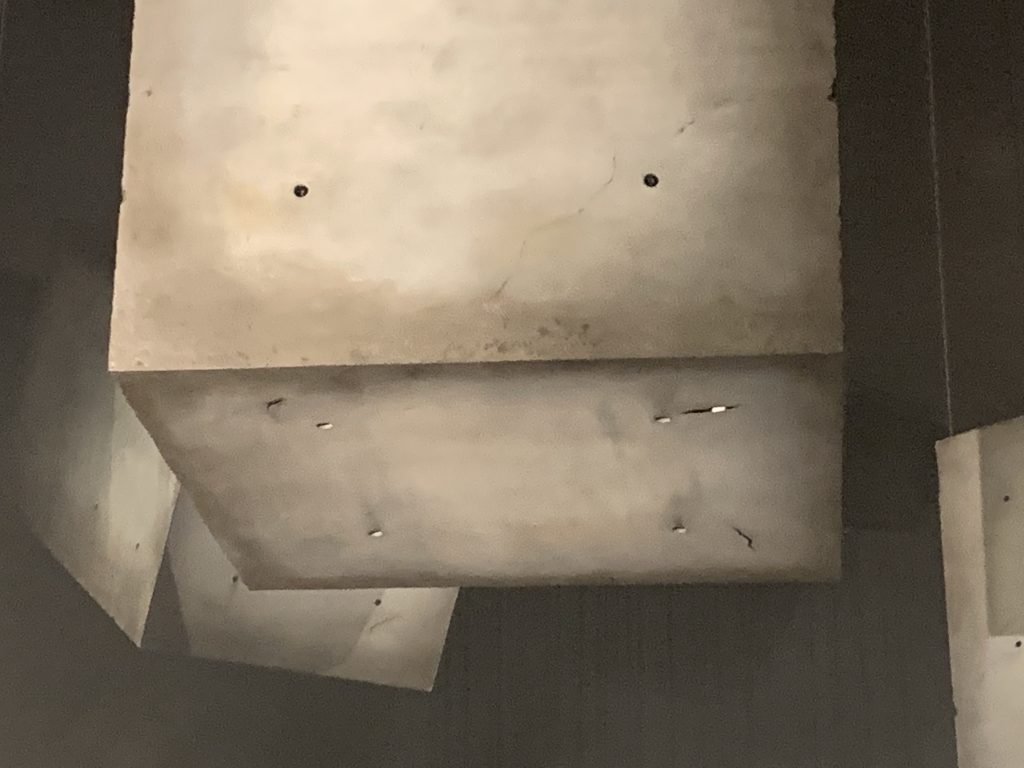
One of the blocks from Drifters. Photo by Ben Davis.
But the “concrete block as symbol of utopian promise” idea does not really land (so to speak), right? It takes too long to figure it out, and the intellectual payoff for the effort is too thin.
I feel like I am being generous to the work by trying to meet it on these terms at all. I mean, at this particular historical moment, in 2021, with the earth’s climate in early-stage meltdown and leaders well aware of near-term catastrophe but spectacularly failing to do anything much to prevent the worst, for serious cultural producers to be pretending that dandelion lamps and hazy mystical symbolism represent some kind of prophetic ecological statement is just freakishly out of touch.
You may be mildly inspired at the Shed that someone figured out how to make something that looks like a movie special effect happen in real life. Alas, the worry that we may not get new and more spectacular immersive installations is not particularly high up on my list of concerns about our fragile future. So as art, Drift’s work does not provide me with some kind of spiritual salve or call to “imagine a different world.” Best to just enjoy it for what it is and then go back to work.
“Drift: Fragile Future” is on view at the Shed, New York, through December 19, 2021.